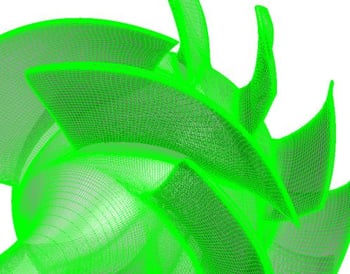Waterjets are increasingly being used as the propulsive method of choice for high speed marine vehicles. A pump designed for waterjet application should have high propulsive efficiency, compact size and low entrained water.
Furthermore, it needs to withstand non-uniform inflow conditions, which have an adverse effect on its hydrodynamic and suction performance. In order to meet these contrasting requirements, a design strategy is required that can consider a large part of the design space and provide information on trade-offs between contrasting design objectives.
Traditionally, waterjet pumps are designed based on empiricism and trial and error approach, in which the impeller and diffuser geometry are modified manually by changes to blade angle distribution. The flow through the resulting impeller (or diffuser) is then analysed by some form of quasi-3D (Q3D) or 3D numerical method.
These methods are then used to evaluate the flow in the pump. However, these methods do not provide any guidance on how the blade geometry should be modified in order to improve the flow field and hence the designer has to rely on trial and error. Such a trial and error process, however, by its nature restricts the designer to relatively small part of the design space, limited to blade angle distributions that have worked in the past, and does not allow the easy exploitation of a wide part of the design space.
An alternative approach to the design of the pump stage is to use an inverse method. In such an approach, the impeller or diffuser geometry is designed for a specified distribution of pressure distribution or blade loading. Since the viscous losses and cavitation behaviour in the pump is to large extent controlled by the 3D pressure distribution, by using this approach one can obtain a more direct control over the design process.
 Fig. 1. Details of the Computational Mesh
Fig. 1. Details of the Computational Mesh
A 3D inverse design approach, TURBOdesign1, that has been extensively used in pump design, proposes a 3D method to design the blade geometry subject to specified blade loading distribution and blade thickness. This method has been used to improve exit flow non-uniformity from centrifugal and mixed flow impellers and eliminate corner separation in diffusers.
Over the years ADT has been involved in thousands of pump designs across all different specific speeds and applications and has developed considerable fluid dynamic knowledge to systematically design high performance pumps, here is a webinar 'Find your Optimum Blade Loading in Pumps' with a summary of some of the main adverse fluid phenomena that cause drop in performances in the impeller and pump stages, and how to fix these issues by finding the optimum blade loading to control specific flow phenomena in pumps.
Furthermore, it has proved to be very effective in developing a very compact mixed flow pump. Development of a compact pump is particularly important in marine waterjet applications, as it reduces the weight of the waterjet system and the amount of entrained water. However, the reduction of volume of the mixed flow pump by 60% is only possible by very careful control of cavitation phenomena, and a design that improves cavitation may have an adverse effect on performance or on Static or dynamic stresses. Hence, the importance of a multi-objective design which takes account of the different contrasting requirements.
In the paper below, we propose a new strategy in which TURBOdesign1 is coupled with Multi-objective Genetic Algorithm in order to create a Pareto Front for the contrasting design requirements.
Mehrdad Zangeneh
Mehrdad Zangeneh is Founder and Managing Director of Advanced Design Technology and professor of Thermofluids at University College London.
View All Articles








Share This Post